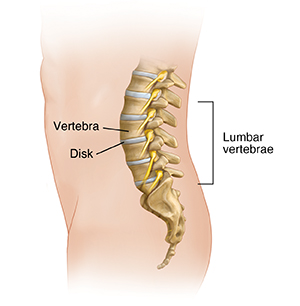Understanding Transforaminal Lumbar Interbody Fusion (TLIF)
A fusion is a surgery to join two or more bones together. A transforaminal lumbar interbody fusion (TLIF) is done on the lumbar spine. Two of the bones of your back (vertebrae) are joined together. The spinal disk between those vertebrae is removed.

Why is TLIF done?
You may need TLIF if you have:
These problems can cause a lot of pain. If pain medicines, physical therapy, or other treatments don’t work, fusion surgery may help relieve the pain.
How is TLIF done?
A surgeon can do an interbody fusion in several ways. TLIF is a minimally invasive surgery. This means it uses smaller cuts (incisions) than other kinds of surgery. The muscles of your spine are not cut. This may help you to heal faster. It may also reduce the chance of some complications.
Your TLIF will be done by an orthopedic surgeon or a neurosurgeon.
-
An orthopedic surgeon is a doctor who specializes in treating bone, muscle, joint, and tendon problems.
-
A neurosurgeon is a doctor who specializes in treating brain, spine, and nerve problems.
You will be face down on the operating table. The surgeon will make one or two small cuts in the skin of your back. They will use special tools called retractors to push aside your back muscles. This lets the surgeon see the spine. The surgeon removes the disk. They put a metal or plastic spacer (cage) with bone graft into the space between your vertebrae. Special metal screws and rods may be used to anchor your bones in place.
What are the risks of TLIF?
All surgery has risks. The risks of TLIF include:
-
Infection
-
Excess bleeding
-
Nerve damage
-
Blood clots
-
The bones may not fuse together well
-
Not enough relief of pain
-
New pain at the site of surgery
-
The need for more surgery
A normal side effect of bone fusion is less flexibility of your spine. In most cases, this limits motion only a small amount and isn’t a major problem.
Your risks vary based on your age and general health. Talk with your healthcare provider about which risks apply most to you.
Online Medical Reviewer:
Anne Fetterman RN BSN
Online Medical Reviewer:
Luc Jasmin MD
Online Medical Reviewer:
Raymond Kent Turley BSN MSN RN
Date Last Reviewed:
12/1/2022
© 2000-2025 The StayWell Company, LLC. All rights reserved. This information is not intended as a substitute for professional medical care. Always follow your healthcare professional's instructions.